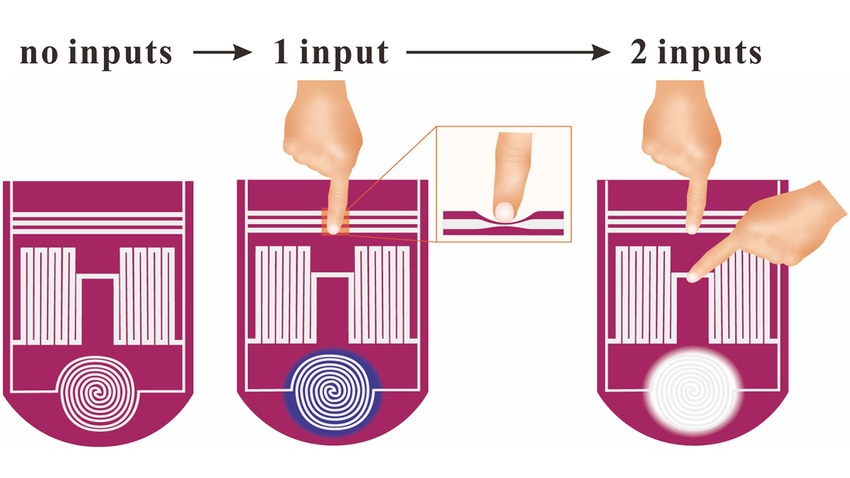Robots that use this material won't need a logic center
Inspired by the octopus, North Carolina State University researchers have developed a structure that handles sensing, computing, and actuation without the need for centralized processing.
November 25, 2019

|
A diagram shows the design of a flexible device inspired by an octopus called “soft tactile logic” developed by researchers at North Carolina State University. The device is part robot, part computer, and decentralizes logic so the device can react independently without needing to connect to a “brain.” (Image source: North Carolina State University) |
Researchers at North Carolina State University (NCSU) have built a unique and flexible device that is part robot, part computer and potentially can be used as a new solution for soft robotics and prosthetic devices. The structure senses, computes, and responds without a logic center or any centralized processing
Michael Dickey, a professor of chemical and biomolecular engineering at NCSU, told Design News the technology, which the researchers are calling “soft tactile logic,” was inspired by the octopus, which has a centralized brain, but also neural structures in their arms. This natural design means the creature’s arms can move independently based on sensory input without needing to refer back to the brain.
“Scientists are trying to understand how the octopus uses these neurons, but it raises the possibility that ‘reasoning’ (logic) could be carried out in the arms,” Dickey explained to us. “We were trying to find some materials that would have soft mechanical properties, but also be able to carry out logic without the need for classical transistors.”
The NSCU team published a paper in the journal Nature Communications.
Principles of soft tactile logic
Dickey said that soft tactile logic encompasses several design principles.
Softness is important because all the materials used are soft and stretchable. “Materials with these properties are of interest for making devices (robots, for example) that can interact with humans,” Dickey said.
Tactility refers to the materials’ ability to respond to touch. And having logic means the device “can carry out simple decisions depending on the input [or touch],” he explained.
At the core of the prototypes the team developed is a common structure – pigments that change color at different temperatures and are mixed into a soft, stretchable silicone form. The silicone contains channels with metal that is liquid at room temperature, which creates a nervous system comprised of soft, flexible wires, Dickey said.
“We have a piece of rubber and inside of it are 'wires' composed of liquid metal,” he said. “When you push the piece of rubber, the liquid metal deforms and, thus, changes its resistance, making it harder for electricity to pass through. If you design the circuit correctly, this change can cause the electricity to flow along a different path.”
As many sensors as a human
Dickey compared the design to blocking a portion of a river, which reroutes the flowing water to new places. “Thus, touching the material reroutes energy to different parts of the material,” he explained. “That energy can be used to do things like change the color of the material, turn on a motor, or turn on a light.”
Dickey said he and his team envision the technology can be used in myriad applications in robotics, prosthetics, and maybe even human-machine interfaces.
“I learned recently that humans have approximately a million sensors in a limb, such as an arm,” he told Design News. “These sensors have to be ‘wired’ to the human brain. Amazingly, biology has figured out how to do this. However, it is not easy to replicate synthetically.”
While this would be very difficult to mimic in a robot – requiring about a million sensors and wires to connect them to centralized logic – researchers hope they have taken “a modest step toward eliminating that complexity and instead, having the ‘computer’ directly as part of the sensor,” Dickey said.
The team plans to continue its work to explore ways to make more complex soft circuits by building more logic into the material. Dickey said the researchers are also are experimenting with how to apply what they have already built.
RELATED ARTICLES:
Elizabeth Montalbano is a freelance writer who has written about technology and culture for more than 20 years. She has lived and worked as a professional journalist in Phoenix, San Francisco and New York City. In her free time she enjoys surfing, traveling, music, yoga and cooking. She currently resides in a village on the southwest coast of Portugal.
DesignCon: By Engineers, For Engineers January 28-30: North America's largest chip, board, and systems event, DesignCon, returns to Silicon Valley for its 25th year! The premier educational conference and technology exhibition, this three-day event brings together the brightest minds across the high-speed communications and semiconductor industries, who are looking to engineer the technology of tomorrow. DesignCon is your rocket to the future. Ready to come aboard? Register to attend! |
About the Author(s)
You May Also Like





